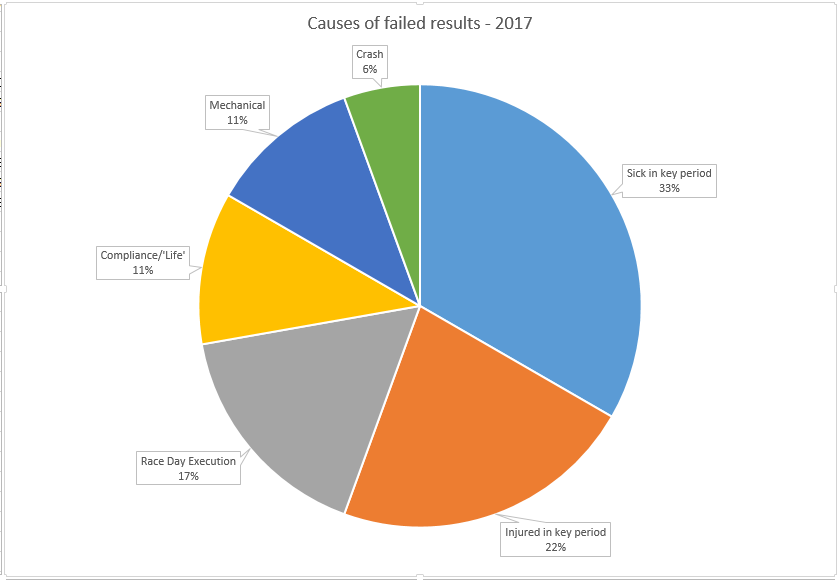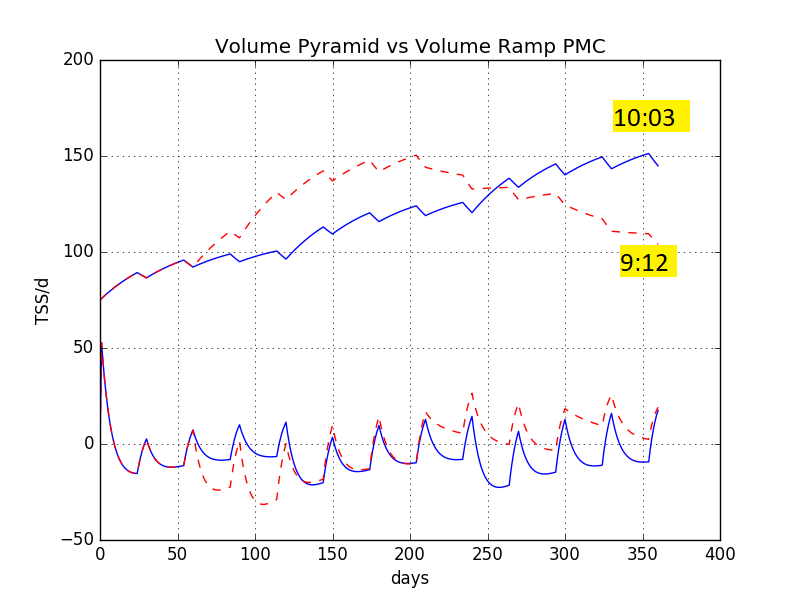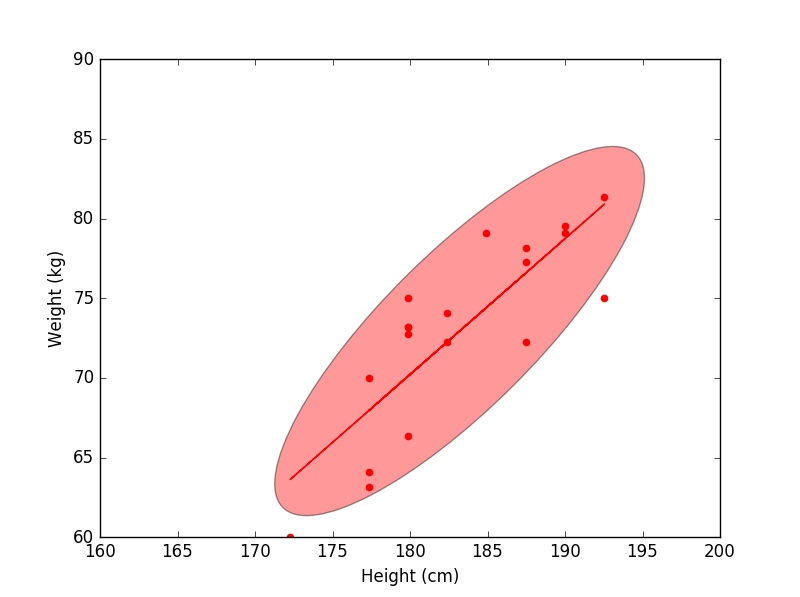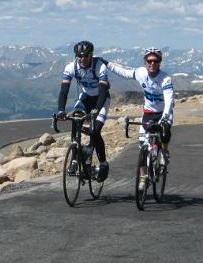What did I learn in 2017?
Alan Couzens, M.Sc. (Sports Science)
December 12, 2017

Despite being a couple of decades in, without fail, every year presents new lessons to me as a coach. Honestly, that's probably what I love most about what I do & while not always easy to swallow at the time, this sport presents us with a never ending opportunity to learn and get better. I present my own observations from 2017 below so that, hopefully, you can gather some useful insight from my experiences (minus some of the pain of the less than positive ones :-)...
2017 was a bit of a roller-coaster year for me & the team. There were a mix of highs, like Magali Tisseyre’s first Ironman podium finish in Ironman Argentina (pictured left), a strong bunch of age-groupers sharing the pure joy of achieving their Kona dream & lows, like poorly timed illnesses, injuries & multiple crashes in and around big races.
To frame things a little more positively, it’s definitely those years that have a few more downs that teach us the most and offer the most lessons moving forward. That’s the purpose of this post, to take a critical look back on some of those limiters for 2017 to see if and to what extent we could have interceded to more positively affect the outcome. So that I can apply those lessons moving forward into another year of coaching.
The reality of Ironman is that is an inherently unpredictable sporting event. Frankly, it has been a bit of a challenge coming from a ‘form sport’ like swimming, where, when an athlete is fit and fresh it consistently shows in their performance. In the sport of Ironman, many, many things can happen over the course of a 8-17 hour day on a real world outside course that spans more than 100 miles that are independent of the fitness the athlete brings to the event. Furthermore, many, many, many things can happen over the 365 days training in ‘the real world’ leading up to when you toe the start line for this event.
Being completely candid, 2017 was the first year in more than a decade of focusing my coaching practice on Ironman athletes that I seriously considered giving it up and moving back to full time swim coaching (or maybe even moving to a completely different career path like more formally pursuing my new passion for machine learning). Don’t get me wrong, my love of the sport hasn’t lessened any but it was a tougher than normal year & my emotional bank account for dealing with athlete disappointment around perceived results that were less than ‘deserved’ was running a little low. I am fortunate that there is a huge amount of positivity on the team and I am surrounded by athletes who gain true, pure #joy in the process of preparing as well as they can year after year, whether their ‘big race’ for that year pans out as planned or not. It is for you guys and gals that I am so thankful & that I recommit to my next decade of helping you as much as I can to go as far as you can in the sport that we both love.
And, if I’m to be honest with myself, it is likely that very complexity & uncertainty of Ironman as a sport that makes me love it so. So many factors need to line up on one day of the year for ‘the perfect’ race to come together. This makes that 'perfect race' all the more elusive and, in my mind, the quest for figuring out all of those little puzzle pieces that lead to the perfect race all the more compelling. In an event as multi-faceted as Ironman, there are always some elements of the puzzle that we can address. Elements of the puzzle that we do have some control over & that is the focus of this post: What lessons can we learn & what elements of the puzzle can we change to improve our rate of success in 2018?
The first step is, of course, to define ‘success’. At the start of each year, we will plan out an annual training plan with each athlete showing what we’re shooting for as far as training volume and intensity through the year and, based on previously observed load/performance relationships what performance that should equate to at the athlete’s key event. So, when looking back on the season, when a goal isn’t achieved, these are the first 2 qu’s that I ask myself…
- Was my model wrong? – Did the athlete hit the load but not get the forecasted performance on race day? If so, why? Race nutrition? Poor race pacing? Environmental issues? Mechanical issues etc? or did I just not know the athlete well enough/have enough data to have a good model?
- Did the plan come off? I.e. was the actual load progression in line with the planned load progression over the year? If not, why not? Compliance/life stuff, illness, injury, overtraining?
The following post will delve a bit deeper into the relative influence of each of these & attempt to break down the frequency & relative importance of each of the above among my team in 2017.
I perform this retrospective analysis each year & I’ve written about it several times in the past. You can read those here, here and here. In looking back at last year, some themes continue to pop up year after year & are tough to solve (like the first below), while some are more easily addressed. Either way, I am hopeful that drawing your (& my) attention to those blind spots that turn out to be common limiters to a successful season can set us off on the right foot for 2018…
So let’s start with a look at 2017 by the numbers…
Of 37 peak (“A”) races this year among the team, 20 of them (~54%) were at or above the goal/forecast. Leaving 17 (46%) that weren’t
Of these ‘failed results’ here is the breakdown of what I am ascribing as the primary cause that the race/season didn’t come off to plan…

So what conclusions/lessons can we draw from the above?
1. Health is your most important attribute, both generally and with respect to getting the performance you deserve from the work you put in.
In the immortal words of Robert Burns – “The best laid plan of mice and men often go awry”. I suspect Burns may have been reflecting on a failed Ironman season when he wrote that
Looking back over my blog posts homing in on the factors contributing to illness and injury in athletes’ this year, it would seem I’ve been obsessed with the topic of athlete health – and for good reason!..."
"Injuries & illness were without question the greatest limiter & the greatest reason that a season didn’t ‘go to plan’, representing more than half (55%) of the 'failed seasons' this year!"
When I ‘did the math’ on these limiters to my athletes 2017 season, it brought to mind, the following tweet from Yann Le Meur, which suggests that injury and illness may be an even greater limiter for international track and field athletes, accounting for 86% of successful seasons among the elite.....
🤒Training availability accounts for 86% of successfull seasons
— YLMSportScience (@YLMSportScience) November 25, 2017
👉🏻⚠️ to the prevention of injury & illness
📍https://t.co/YBipQP3RyK pic.twitter.com/PtuHzERpbG
These numbers line up well with my own experience. If we take out the role of ‘mechanicals’, ‘course conditions’ and, presumably, at that level, athlete compliance, injury and illness is left making up an even greater chunk of the pie!
With the huge importance of illness and injury prevention to goal achievement, It goes without saying that preventing injury and illness is going to continue to be an area of focus in 2018 (i.e. expect more blogs :-). But it won't be an easy fix. Athletic injuries are a complex, multi-faceted phenomena. There are a whole host of factors at play and it’s not just about the introduction of frequent strength and mobility ‘prehab’ work (although that definitely helps!) There are many factors that lead to an injured athlete both relating to the athlete’s training plan and the athlete’s general life! Here is what I have so far…

* Minimize time at extreme levels of load – My data would suggest that the risk of injury increases by a factor of 5 when CTL increases above 120 TSS/d!
* Keep acute:chronic ratios at low-moderate level (less than 1.5): Put together with the above this means, be patient (not a patient) in your progression over the long term.
* Manage training in accordance with life stress: High levels of life stress and high levels of training stress don’t go together! Next to pure load, high ratings of life stress is the feature most predictive of injury in my sample…
* Only go hard when you need to (and when it's safe to do so): Intensity of training is a big factor in the frequency of injury/illness in athletes. At an average I.F of 0.8 vs 0.7, for the same training volume, injury risk increases by ~50%. While, increases in intensity are necessary at some times of the year, keeping this is mind & not piling of – training load + training intensity + life stress at the same time will have a significant effect on minimizing this risk.
As a final comment on the injury/illness front, I can, without question, say that the athletes with the ‘busiest lives’ are the ones who exhibit the highest rates of injury and illness. While interceding, on this front, may be beyond my scope as an athletic coach (at least among the working amateurs), I feel a certain responsibility in sharing this observation and encouraging the simplest, most stress-free life possible if athletic success is a high priority and even if it's not, I still encourage the most simple, stress-free life possible :-)
2. (On the positive) It’s not all about (CTL/TSS) load!
I dove further down the rabbit hole of using mathematical modelling to optimize the training process this year.
In doing so, I came away with an important conclusion...
"By separating volume and intensity into independent variables, we can get a much better prediction of what performance we can expect from a given training plan than by lumping them together in a CTL/TSS metric."
Specifically, running an example of a ‘volume pyramid’ vs a ‘volume ramp’, through this multi-variate model, I found that my data showed an improved performance of ~50minutes to Ironman performance despite a significantly lower race day CTL!

In this case, despite a difference in race day CTL of ~110 vs 150, the predicted performance was ~50min faster. Whaaaat? Less CTL, more performance? Yes. By looking at volume and intensity as independent types of load and separating out these volume and intensity emphasis periods and allowing enough time to employ some stabilization/maintenance blocks and accommodate/’grow into’ the load with some specific race intensity work, we can expect a significantly higher level of performance. Put another way, the year should be about more than maximizing aerobic base via CTL. Enough time needs to also be allowed to transform that base fitness into race specific fitness. In this sense, maintenance isn’t a dirty word!
I recognize that it’s going to be tough to break from seeing that little blue line go up & up and up through the season, though. This next level of performance modeling represents a real paradigm shift. Some of the models that I have been using, like neural networks are significantly more complex than a simple ‘one number’ TSS model. I still don’t have a great solution for how we are going to convince athletes & coaches to break away from the old TSS way of doing things. But I am becoming all the more convinced that we have to find a way to make this leap. Given the clear benefit in using these better models, I will be devoting more time to coming up with some practical implementations of them over the next year.
3. Body type/Body comp. matters when it comes to racing & we’re just as misguided in the way we try to change it as ever! :-)
Without question, the (surprisingly) most controversial post that I made was on height/weight ratios of elite athletes...

I got a lot of feedback that suggested that it was ‘irresponsible’ of me to throw numbers out there & that it may even push folks into developing an eating disorder! I was a bit surprised by that, because, in my view the typical BMI range for elite triathletes is actually much ‘healthier’ & broader than a lot of other sports!
Believe it or not, the other side was represented as well – folks who were below the elite norms asking if they could benefit from adding some weight. Given the importance of strength to Ironman, I would generally say yes!
"Given the differences in courses and environs, ‘Ironman racing’ can mean a lot of different things and it is important that the athlete is as well suited as possible to the demands of the courses they will face. Even when bringing in very high levels of general fitness, an athlete can be carrying too much mass for a hot course. They can be too skinny to have the strength for a flat/windy course. They can be too short for a good non-wetsuit swim. They can be too heavy for a course with significant climbs…the list goes on..."
To an extent, some of this is fixed and some is malleable. The fixed part speaks to the importance of selecting courses that match your strengths, while the malleable bit speaks to the importance of focusing your training/nutrition plan on addressing any weaknesses in a healthy way.
This year was a good reminder of the very human blindspots that even very high level athletes can face on both fronts. Choosing races that don’t suit their natural abilities and ignoring their strengths in training while becoming so obsessed on their perceived weaknesses that they start to lose those strengths!
Especially, when it comes to nutrition, our tendencies towards the extreme can work against us. There are plenty of systems and programs that cater to these extremes – fasted training, high carb, low carb etc etc. It can be tough to stay true to a system that treads that (boring) middle ground of gradually chipping away towards our goal body comp while continuing to fuel the training nutritiously and in a metabolically beneficial way. I suspect I will be devoting more time to reiterating this middle path in the coming year.
4. The process of finding a good athlete-coach relationship is a lot like e-harmony 😊

My biggest revelation for 2017: I’m a weirdo! :-) There I said it! And here’s another revelation – so are you!
Your weirdness may be a little less extreme than my own and you probably cover it up a bit better but we all have certain personality quirks that make us unique Some are perceived as strengths – e.g. I’m like a Pitbull when it comes to applying myself to figure out a puzzle. Some are perceived as weaknesses, e.g. I am very shy and generally prefer time bouncing thoughts around in my own noggin to chit-chat, especially of the vapid, common type. Additionally, I’m more passionate than I might first appear. I have zero tolerance for folks who don’t put their full heart into something and a deep kinship for those who do. You see where I’m going with this…
As the years pass, I find that the coaching relationships that 'click' are less about the in’s and out’s of the training plan and more about finding the perfect coach-athlete 'match' – where my strengths complement the athlete’s weaknesses and vice versa (to the extent that we can easily overlook any of the minor irritants that come with sharing a part of your life with another human :-) , & yet, where we can still find a common ground and deep mutual respect in our shared passion.
Being in a ‘bad fit’ can be a painful experience for both concerned but finding those ‘right fits’ makes the whole experience worth it. Foibles and all!
While the painful experiences aren’t going to turn me away from my passion, you can rest assured that I’m going to turn my brain to come up with some sort of algorithm that might minimize that probability percentage of that occuring :-) Enter IBM Watson….
Following the e-harmony precedent, I started to apply some ‘AI’ to help with this – in the form of IBM Watson’s personality insights API this year as a ‘screening tool’ for prospective new coach-athlete relationships. So far so good on that front(!) and, given the huge potential benefit to both coach and athlete, I will continue to be implementing and developing this in the coming year. In other words… open, conscientious, introverted, disagreeable old coach seeks conscientious, agreeable, extraverted athletes to create some magic together! :-)
5. The next decade will see an exponential growth in learning from 'real world' data and using augmented intelligence in coaching.
Two important long-term trends are working together: 1) our world and our lives are increasingly made of pure (digital) information, 2) (digital) information systems are becoming ever more intelligent
— François Chollet (@fchollet) December 10, 2017
As Francois Chollet, an expert in machine learning says above, the amount of digital information increases every year and thus those who can access and 'speak with' said information are at a considerable (& growing) advantage.
With every year that passes, I come to that same realization - that my computer (or more specifically, my ability to ‘talk to’ my computer) is both a time saver & a game changer!
This extends beyond the obvious advantages in building athlete training plans. It extends to learning. I did the “That Triathlon Show” podcast a few weeks back & when Mikael asked me what my greatest resource (book, blog etc) was, I responded that my greatest resource is the athletes I work with! Cheesey as it sounds, that was the absolute truth. The athletes that I have the privilege to work with are, absolutely, who I learn the most from and gather the most valuable insights from.
"With every year that passes, I collect more data and more ability to programmatically dive into that data to mine insight. I have found this process exponentially beneficial compared to the traditional learning route of reading books and journals. The data is bigger, it’s over a longer time span (not a 12 week study, but sometimes a decade or more of working with a single athlete!) & it’s more ‘real life’."
This year (with the hearty endorsement of my wife :-) I have found myself spending less money and time reading books and journal papers and more time developing my skills in writing code to gain insight from and learn from my team’s data. I believe strongly enough in the benefit of this insight that I 'put my time where my mouth is' and put a lot of hours into rewriting my team's online training logging system in Python because there is simply no better programming language for mining insight from web-based data than my beloved Python! As I complete that arduous task, I'm super excited to dive further into the insights uncovered over the next year!
Unsurprisingly then, my greatest focus for the next year will be to continue to develop my ‘A.I. Assistant Coach‘ to ‘automate the boring stuff’ so that it takes less time away from the fun stuff! – learning, gathering insight, applying these insights to the athletes that I am working with & being a part of their continued improvement. Given the incredible advances that happen in this technology every year, we have an exciting future ahead!.....
#AI Sophia is #talking to one of her #creaters so #cleverly.Do you #think so? pic.twitter.com/RqxYNCiBSD
— Science Academy (@SienceAcademy) November 12, 2017
#####
The summary of the summary…
* Protect your health at all costs & I do mean at all costs. You have no more valuable asset as both an athlete and a person.
* Effective training is about much more than a single load number.
* Guard and develop your strengths as an athlete and pick races/events that suit them.
* Choose who you take with you on your journey very carefully and make choices that you can commit to, especially during the hard times.
* Record everything and put in the necessary time to truly learn from your own experiences and if you’re fortunate enough to be a coach, the experiences of your team!
Here’s to continued learning and improvement in 2018 and beyond!
Train smart,
AC
TweetDon't miss a post! Sign up for my mailing list to get notified of all new content....
